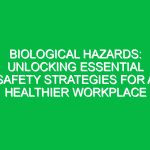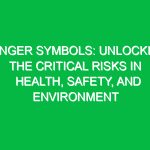Introduction
The danger symbol serves as a universally recognized icon, alerting individuals to potential hazards in various settings, from workplaces to public areas. In the Health, Safety, and Environment (HSE) domain, understanding these symbols is crucial for preventing accidents and ensuring safety. Every day, people encounter these symbols, yet many may not fully comprehend their significance or the implications they carry. This article delves into the critical aspects of danger symbols, emphasizing their importance in fostering a culture of safety and environmental responsibility.
Understanding Danger Symbols
At their core, danger symbols are visual indicators that communicate specific risks associated with substances, processes, or environments. These symbols are often standardized, making them recognizable regardless of language barriers. For instance, the iconic skull and crossbones signifies toxic substances, while the flame symbol indicates flammable materials. Understanding these symbols is not merely about recognition; it’s about comprehension. A worker who sees a “corrosive” symbol must grasp the dangers of handling such substances and know the appropriate safety measures to implement.
Key Aspects of Danger Symbols in HSE
Danger symbols play an integral role in the HSE framework by promoting awareness and education regarding potential hazards. Here are some essential components of danger symbols in this context:
- Communication of Risks: Danger symbols effectively communicate risks in an immediate and clear manner. They transcend language and literacy barriers, making them vital in diverse workplaces, where employees may speak different languages. The simplicity of these symbols ensures that everyone can recognize the hazards.
- Prevention of Accidents: By alerting individuals to specific dangers, these symbols can prevent accidents before they happen. For instance, clear labeling of hazardous materials in a laboratory can mitigate the risk of spills or exposure.
- Training and Compliance: Incorporating danger symbols into safety training programs enhances compliance with safety protocols. Employees who are trained to understand and respect these symbols are more likely to adhere to safety guidelines.
- Legal Implications: Many industries are governed by regulations that mandate the use of danger symbols. Non-compliance can lead to legal repercussions, underscoring the need for organizations to familiarize themselves with relevant standards.
The Importance of Hazard Recognition
Recognizing hazards is the first step toward maintaining a safe environment. Danger symbols are designed to evoke immediate recognition of these hazards. For instance, a vivid yellow triangle with an exclamation mark warns of general hazards. But what happens when workers overlook these symbols? Consider a scenario in a chemical plant where employees fail to notice the “toxic” symbol on a container. A lack of attention could result in serious health risks or even fatalities. Therefore, ensuring that these symbols are prominent and understood is a critical aspect of workplace safety.
Real-life Examples and Insights
To illustrate the real-world application of danger symbols, we can look at various industries. In construction, for instance, the presence of a “fall hazard” symbol signals to workers the need for safety harnesses and other protective gear. A construction site supervisor might recall an incident where a worker disregarded this symbol, leading to a near-fatal accident. This anecdote reinforces the importance of adherence to safety signage and protocols.
In healthcare settings, the “biohazard” symbol is crucial for indicating materials that pose a risk to health. During my time volunteering at a local hospital, I witnessed how staff trained in recognizing and responding to biohazard symbols were able to respond swiftly to a potential contamination incident, effectively mitigating risk. This experience highlighted the life-saving potential of simply understanding and respecting danger symbols.
Best Practices for Implementing Danger Symbols
Organizations can adopt several best practices to ensure danger symbols are effectively utilized and understood:
- Training Programs: Regular training sessions should be held to educate employees about the meaning and implications of various danger symbols. This training should include practical exercises that reinforce recognition and response protocols.
- Regular Audits: Conducting safety audits can help identify areas where danger symbols may be missing or poorly displayed. Audits ensure that the workplace remains compliant with safety regulations.
- Clear Visibility: Ensure that danger symbols are displayed prominently and are visible from a distance. Use high-contrast colors and adequate lighting to enhance visibility.
- Feedback Mechanism: Establish a feedback mechanism where employees can report any issues with danger symbols or suggest improvements. This involves them in the safety culture and encourages proactive behavior.
Regulations and Standards Governing Danger Symbols
Various regulations and standards govern the use and interpretation of danger symbols within the HSE framework. In the United States, the Occupational Safety and Health Administration (OSHA) enforces standards that require proper labeling of hazardous materials. Globally, the Globally Harmonized System of Classification and Labelling of Chemicals (GHS) provides a framework for hazard communication, including standardized symbols. Understanding these regulations is essential for organizations to avoid legal issues and ensure worker safety.
The Impact of Non-compliance
Failure to adhere to safety regulations regarding danger symbols can have severe consequences. For instance, a manufacturing company that neglects to label hazardous substances appropriately could face significant fines, not to mention the potential for workplace accidents. The financial implications can be staggering, but the human cost often outweighs these concerns. In cases of injury or fatality, the emotional and reputational damage can tarnish an organization’s legacy.
Conclusion
In conclusion, danger symbols are not just simple images; they represent critical information that can save lives and prevent accidents in various settings. Understanding and respecting these symbols is a shared responsibility among employees, management, and regulatory bodies. As we continue to navigate an increasingly complex world, fostering a culture of safety that prioritizes HSE awareness is paramount. By recognizing the importance of danger symbols, we can all contribute to a safer and more sustainable environment. It is imperative that organizations not only comply with safety regulations but also cultivate an atmosphere where safety is ingrained in every action, ensuring that danger symbols fulfill their essential purpose.


